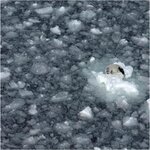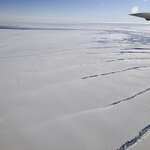Oceanography

A recent review of research on the response of plants, marine life and animals to declining sea ice in the Arctic found that sea ice decline and warming trends are changing the vegetation in nearby arctic coastal areas.
The review team analyzed 10 years worth of data and research on the subject. The findings show that sea ice loss is changing marine and terrestrial food chains. Sea-ice disappearance means a loss of sea-ice algae, the underpinning of the marine food web. Larger plankton is thriving, replacing smaller, but more nutrient dense plankton. What that means exactly is not yet…

The Earth has periodic ice ages - every 100,000 years, give or take, and the ice ages last far longer than the warm periods.
In the last century, scientists determined that Earth's ice ages were determined by the wobbling of the planet's orbit, which changes its orientation to the sun and affects the amount of sunlight reaching higher latitudes, particularly the polar regions. The Northern Hemisphere's last ice age ended about 20,000 years ago and then the ice age in the Southern Hemisphere ended about 2,000 years later, suggesting that the south was responding to warming in the north.…

A year-round ice-free Arctic Ocean surface could explain why the Earth of the Pliocene Epoch had the levels of carbon dioxide in the atmosphere that we have today, but we remain 3 to 9 degrees cooler than the Earth was then.
In early May, instruments at the Mauna Loa Observatory in Hawaii marked a record: The concentration of carbon dioxide climbed to 400 parts per million for the first time in modern history. Meanwhile, warming was paused. The last time researchers believe the carbon dioxide concentration in the atmosphere reached 400 ppm, between 3 and 5 million years ago during the…

A new projection estimates that by the middle of this century there could be an average 56 percent drop in the amount of water stored in peak snowpack in the McKenzie River watershed of the Oregon Cascade Range - if there is a 3.6 degree Fahrenheit temperature increase.
Similar impacts may be found on low-elevation maritime snow packs around the world.
The Oregon State University numerical model highlights the special risks facing many low-elevation, mountainous regions where snow often falls near the freezing point. In such areas, changing from snow to rain only requires a…
Scientists using tracking data from Garwood Valley in the McMurdo Dry Valleys region of Antarctica have documented an acceleration in the melt rate of permafrost - ground ice - in a section of Antarctica where the ice had been considered stable.
The melt rates are comparable with the Arctic, where accelerated melting of permafrost has become a regularly recurring phenomenon, and the change could offer a preview of melting permafrost in other parts of a warming Antarctic continent, says Joseph Levy, a research associate at The University of Texas at Austin's Institute for Geophysics.
The…

Shrinking sea ice cover in the North Atlantic - baby harp seals impacted most.
A new paper says satellite images have allowed researchers to gauge the relative roles that genetic, environmental and demographic factors such as age and gender may be playing in harp seal stranding rates along the U.S. and Canadian east coasts in recent years. Recent warming in the North Atlantic gets the blame, according to the paper by advocacy group the International Fund for Animal Welfare and Duke University.
Harp seals rely on stable winter sea ice as safe platforms to give birth and nurse…

A potential barrier to deep Antarctic circumpolar flow until the late Miocene?
Scientists have found geologic evidence which casts doubt on one of the conventional explanations for how Antarctica's ice sheet formed.
The Antarctic circumpolar current (ACC), an ocean current flowing clockwise around the entire continent, isolates Antarctica from warmer ocean water to the north, thereby helping to maintain the ice sheet. For several decades it has been surmised that the onset of a complete ACC played a critical role in the initial glaciation of the continent about 34 million years ago.
Now,…

If warming projections exceed estimates and rise by 1 degree Celsius, a new computer model finds that sea levels will rise about seven feet - over the next several thousand years.
But that would be duplicated for every degree of additional warmth as well.
The paper in the Proceedings of the National Academy of Sciences combined analyses of four major contributors to potential sea level rise into a collective estimate, and compared it with evidence of past sea-level responses to global temperature changes.
Estimates are that the four major contributors to sea-level rise on…

Satellite observations of the ice sheets of Greenland and the Antarctic haven't been around long enough, and prior methods were too inaccurate, to be able to say whether the loss of ice today will persist in the future.
Predictions of the contribution of both ice shields to the sea level by the year 2100 may be off by more than 35 centimeters - but whether they will be too high or too low is unclear. Too high is obviously no problem. Too low could be a real worry.
The researchers writing in
Nature Geosciences
analyzed nine years' worth of data from the gravity field satellite GRACE. The…

In October of 2011, NASA's Operation IceBridge flights over the continent over Antarctica spotted a rift that soon became the focus of international scientific attention. Seeing the rift grow and eventually form a 280-square-mile ice island gave researchers an opportunity to gather data that promises to improve our understanding of how glaciers calve.
This week the European Earth-observing satellite TerraSAR-X confirmed that a large iceberg broke off of Pine Island Glacier, one of Antarctica's largest and fastest moving ice streams.
Although calving events like this are a regular and…